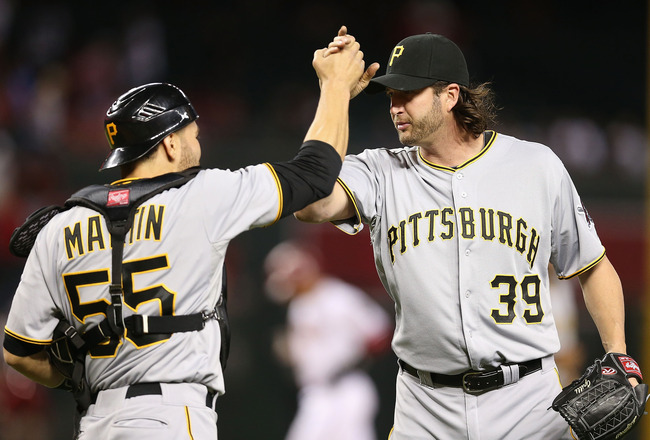The team's front office turned the franchise from a punchline to a contender by using their revenue-sharing profits to build a promising farm system. MLB, take note.
By ALLEN BARRA
July 9, 2013

What a difference three years makes.
As we head into this year's mid-season All-Star Game break, the Pittsburgh Pirates, formerly the perennial worst team in baseball, have the best record in the game (well, they're tied with their division rivals, the St. Louis Cardinals). So after their 20th consecutive losing season last year--a record for the most consecutive losing seasons in any of the four pro sports--how did the Pirates manage to become the best team in baseball? By getting creative with the money they made through revenue-sharing.
The Pirates' transformation began in 2010; back then, they were terrible, even by their own standards. The team finished 57-105, 34 games behind the division-winning Cincinnati Reds. In 2011 and 2012,the Pirates extended their own record for futility--their 72-90 mark last year made for 20 straight seasons in the tank. If postseason play is the measure of a team's success or failure, the Pirates have been a disaster since 1992, the last time they were in the playoffs. And if you go by world championships, it's even worse: The last ring winner was Willie Stargell's 1979 "We Are Family" team.
2010 was also the year that documents were leaked revealing that three major-league franchises--the Pirates, the Florida Marlins, and the Tampa Bay Rays--actually made money and in fact made substantial profits from losing. Under the MLB revenue-sharing plan, small-market, lower-revenue teams get a kickback from the richer teams' local TV profits. In theory, this wealth-redistributing dose of socialism should give the poorer teams a chance at parity. But what the leaked documents seemed to indicate was that the Pirates, Marlins, and Rays weren't putting those funds toward competing for free agents but instead pocketing the revenue-sharing checks.
In reality, that's what the Marlins and Rays were doing. But though the press came down particularly hard on the Pirates ("MLB Should Dump the Pittsburgh Pirates From Revenue Sharing," a headline on Bleacher Report read), what the press didn't understand was that at the time, the Pirates were in the midst of a radical overhaul from the bottom up. Between 2008 and 2011, owner Robert Nutting and general manager Neal Huntington spent nearly $50 million--more than any other team in baseball--on scouting and signing young talent in the amateur draft. They poured millions more into stocking their farm system with the new prospects--unlike other owners and managers who prioritized their teams' main rosters.
The results of Nutting and Huntington's unorthodox approach have been dramatic. Now that the Pirates are tied for first place, a black baseball cap with a bright yellow script "P" is suddenly baseball chic for the first time in nearly two decades. The Pirates are selling out at home, moving merchandise hand-over-fist, and even becoming a road attraction.
One-half of a baseball season doesn't make a pennant winner, of course, but thanks to their shrewd tactics in scouting and signing promising amateur players, the Pirates will face the rest of the schedule with the best array of young talent on any major-league roster. After 87 games, Pittsburgh leads the majors in overall ERA, 3.14. Starters Jeff Locke (age 25), Francisco Liriano (29), Jeanmar Gomez (25), and Gerrit Cole (22) have won a remarkable 22 of 26 decisions. Their relief corps has kept pace with the starting pitching, too, holding hitters to the lowest batting average of any bullpen in the National League.What the Pirates aim for is to be ahead after six innings when they hand the ball to "hold" guy Justin Wilson (ERA 2.06),set-up man Mark Melancon (ERA 0.87), and, finally, sure-to-be-All-Star closer Jason Grilli (2.15 ERA, with 28 saves).
At bat, they're not nearly so potent, ranking just 12th out of 15 teams in runs scored. But in All-Star center fielder Andrew McCutchen, third baseman Pedro Alvarez, and left fielder Starling Marte, they have three young hitters who all rank in the top 25 among the league's batters in combined On-Base Average and Slugging.
While most of the Pirates' talent is homegrown, the front office has also made judicious use of the free-agent market.Catcher Russell Martin, a former free agent who signed a two-year contract with the Pirates in the off-season, has batted near a respectable .250 mark all season with excellent power (he's hit nine home runs as of today). He is also a superb defensive catcher, an excellent handler of pitchers who has thrown outa career-high 49 percent of would-be base stealers so far this season.
There's a delicious irony to how the Pirates got Martin that points to an oddity that keeps big-market teams from dominating the game. Last season, Martin was the regular catcher for the New York Yankees; it is widely rumored that the Steinbrenner family has been cutting the Yanks'payroll, the highest in baseball, to make the franchise more attractive to prospective buyers. Whatever the reason, the Yankees let Martin, who made $7.5 million last season--not a particularly high sum for an experienced catcher who can hit with power--go to the Pirates, who signed him for a bargain $6.5 million. (Next year,he'll make $8.5 million.) Simply put, the Yankees, in an attempt to cut their payroll, practically handed the small-market Pirates one of their most valuable players.
The Yankees' 2013 payroll is estimated to be nearly three times the Pirates'. Yet Pittsburgh's win-loss percentage is more than 60 points higher than New York's. Whether the Steinbrenners decide to sell or not, they could benefit from a look at the Pirates' business model.
ALLEN BARRA writes about sports for the Wall Street Journal and TheAtlantic.com. His latest book is Mickey and Willie--The Parallel Lives of Baseball's Golden Age.
No comments:
Post a Comment